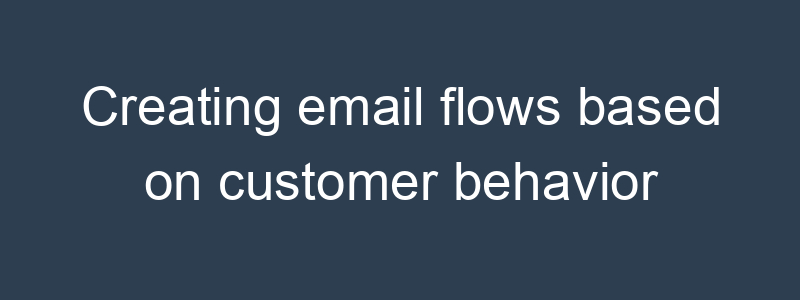Creating email flows based on customer behavior in Klaviyo allows you to send highly targeted and timely messages that can significantly improve engagement and conversions. Here’s how to set up behavior-based email flows in Klaviyo:
Steps to Create Behavior-Based Email Flows in Klaviyo
1. Log into Klaviyo
- Navigate to Klaviyo’s website and log in to your account.
2. Create a New Flow
- Go to the “Flows” tab on the left-hand side of the dashboard.
- Click on the “Create Flow” button.
3. Choose a Flow Template or Start from Scratch
- Klaviyo offers several pre-built templates for common behavior-based flows like Abandoned Cart, Browse Abandonment, and Post-Purchase Follow-Up. Select a template or start from scratch by selecting “Create from Scratch.”
4. Define the Flow Trigger
- The trigger determines when the flow will start. Common behavior-based triggers include:
- Checkout Started: For abandoned cart emails.
- Viewed Product: For browse abandonment emails.
- Placed Order: For post-purchase follow-up emails.
- Opened Email: For re-engagement based on email interactions.
5. Set Up Flow Actions
- Email Actions: Drag and drop the “Email” action to the flow builder. Configure the content of each email to be sent at different stages.
- Time Delays: Add time delays between actions to space out your emails. For example, wait 1 hour before sending the first abandoned cart email.
- Conditional Splits: Use conditional splits to create different paths based on customer behavior. For example, send different follow-up emails to customers who purchased a product versus those who didn’t.
- SMS Actions: If you use SMS marketing, you can add SMS actions to your flow to reach customers via text messages.
6. Customize Email Content
- Personalize your emails with dynamic content, such as the customer’s name, the products they viewed or added to their cart, and other relevant information.
- Use Klaviyo’s drag-and-drop editor to design visually appealing and on-brand emails.
7. Set Up Flow Filters
- Add filters to include or exclude contacts based on specific conditions. For example, exclude customers who have already made a purchase from receiving further abandoned cart emails.
- Click on “Flow Filters” and set up conditions such as “Placed Order at least once since starting this flow.”
8. Review and Activate Your Flow
- Review the entire flow structure to ensure all emails and actions are set up correctly.
- Activate the flow by toggling the switch in the upper right corner of the flow builder.
Example Behavior-Based Email Flows
- Abandoned Cart Flow:
- Trigger: Checkout Started
- Email 1 (1 Hour After Abandonment): Reminder of the items left in the cart with a CTA to complete the purchase.
- Email 2 (24 Hours After Abandonment): Additional reminder with a potential discount offer.
- Email 3 (72 Hours After Abandonment): Final reminder with a sense of urgency (e.g., limited stock or offer expiration).
- Browse Abandonment Flow:
- Trigger: Viewed Product
- Email 1 (1 Hour After Browsing): Reminder of the product viewed with recommendations of similar items.
- Email 2 (24 Hours After Browsing): Follow-up with customer reviews or additional product details.
- Email 3 (72 Hours After Browsing): Incentive to purchase, such as a discount or special offer.
- Post-Purchase Follow-Up Flow:
- Trigger: Placed Order
- Email 1 (Immediately After Purchase): Thank you email with order details and next steps.
- Email 2 (7 Days After Purchase): Request for product review or feedback.
- Email 3 (14 Days After Purchase): Tips for using the product and suggestions for complementary products.
- Email 4 (30 Days After Purchase): Introduction to loyalty or referral program.
- Re-Engagement Flow:
- Trigger: Opened Email but no purchase
- Email 1 (7 Days After Last Interaction): Re-engagement email with a special offer.
- Email 2 (14 Days After Last Interaction): Highlight of new products or content.
- Email 3 (30 Days After Last Interaction): Final attempt with a personalized offer or discount.
Tips for Effective Behavior-Based Flows
- Personalization: Use customer data to personalize the content of your emails, making them more relevant and engaging.
- Clear CTAs: Ensure each email has a clear and compelling call-to-action to guide the customer towards the desired action.
- Timing: Space out your emails appropriately to avoid overwhelming the customer while keeping your brand top-of-mind.
- A/B Testing: Continuously test different subject lines, email content, and send times to optimize performance.
- Analytics: Monitor the performance of your flows using Klaviyo’s analytics. Track key metrics such as open rates, click-through rates, and conversions to identify areas for improvement.
By following these steps, you can create effective behavior-based email flows in Klaviyo that engage your audience and drive conversions. If you need further assistance or have specific questions, feel free to ask!


